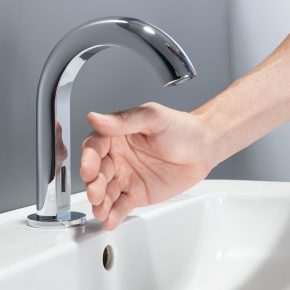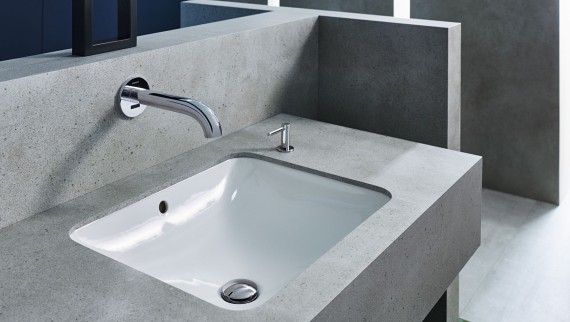
Geberit lifts the lid into the future of life in the office
A panel discussion hosted by Geberit explores the future of the office post-COVID.
The return to the office has already begun. For many, the return is surprisingly good news. They miss the office and the human connections that come with it.
Homeworking anxieties
Many office workers’ concerns focus on safety, health and hygiene. They wonder what a ‘COVID-secure’ workplace is, and if it is possible? They also remember the headlines about major workplace outbreaks last time working-from-the-office was possible.
In the worst case as many as 600 workers tested positive at the DVLA’s Swansea offices. Whilst office workers confront their health concerns, the people who own the UK’s office buildings face alarms and anxieties of their own.
The landlords also wonder what a ‘COVID-secure’ office involves, and at the same time worry that their business tenants use homeworking as an excuse to reduce the amount of floorspace they occupy.
They have good reason to fret: major corporates like BP and HSBC have said they expect staff to work from home about two days a week.
The answers to both the office worker’s and the office landlords’ problems revolve around improved but invisible hygiene, the so-called ’de-densification’ of the workplace.
Bathroom designer and manufacturer, Geberit, carried out a YouGov poll in February 2021 of 1,000 office staff on their views on working life during the pandemic and their thoughts on returning to the office once restrictions are lifted. The results are unexpectedly positive for the traditional office.
An overwhelming majority (76%) were willing to return to the office, with half of them were already back behind their desks. A majority (51%) said they missed socialising with colleagues, and the plurality said they also missed getting out of the house and face-to-face meetings. Some even miss the daily commute to work (8%).
But the poll also revealed that 47% have reservations about surfaces and touchpoints in the office, and 37% of respondents are worried about standards of washroom hygiene.
Dexter Moren is an architect with a practice spanning Europe and Asia. According to Moren, office designers and landlords need to think more closely about issues of proximity – meaning the simple fact of people being close together.
This isn’t just about social distancing but about the way offices work.
Moren comments: “One of the big ideas of office workspace in the last few decades has been the open plan office, as opposed to individual cellular offices. Today people will probably be more comfortable being further apart at work than they were before COVID-19, and that probably means less demand for offices but more demand for floorspace.”
This has become known as ‘de-densification’ and it reverses the trend of several decades in which crowding people into offices became the norm. 20 years ago, each worker was notionally allocated between 150-200 square foot each.
By the time the pandemic struck last year this had fallen dramatically, down to 80-100 square foot in some workplaces. If this goes into reverse it will require high-level rethinks of how much office space is needed, and how it is used, Moren says.
Moren also predicts that the workstation-sharing and hot-desking trends of the last few years will be called into question. That is because obvious issues of hygiene arise if workstations are shared.
His conclusion is straightforward: “It will come down to space, and cleanliness, and a sense of comfort, and there won’t be the desire to pack people in like there was in the past.”
Does this mean a return to the old-fashioned cellular office, with a door that shuts and a full-height wall from floor to ceiling? Maybe, says Moren.
“There will be a desire for individual offices, if only because that way nobody else can come too close,” he says.
But if office workers are keeping their distance, how can there be the usual workplace hustle and bustle? The snatched conversations, bumping into colleagues, and the huddle around the water-cooler or the kettle, are all part of the way offices work. Psychologists say these and other micro-interactions make workplaces fruitful – they will all be lost, surely?
Dr Chiara Amati is a chartered occupational psychologist at the Keil Centre, an Edinburgh-based specialist consultancy focusing on workplace wellbeing. She says that if you prevent close encounters of the workplace kind, you risk killing workplace creativity.
That is because there will be less of the small, frequent encounters that help create connections, and these collisions of people and personalities in turn create ideas.
Amati says: “There is something about the way we interact when we share a physical space. If we meet on Zoom or Teams, idea generation isn’t so fluid. And whilst that doesn’t matter much in any individual instance, over an entire organisation it could lead to quite big differences.
“Organisations will have to figure out how to manage the health risks, but there’s a lot to lose if you lose proximity.”
She warns employers not to rush for simplified solutions and, in the process, miss the spontaneous connections that they ought to value.
The difficulty is that some members of staff will take very different views of the risk involved a post-COVID return to work. Whilst for one member of a team the risk may seem small and manageable, for another it might be a cause of an almost clinical level of anxiety.
This spectrum of concern is most visible in our attitudes to places associated with hygiene, like workplace washrooms.
Lynne Clapham-Carter is specification sales manager at Geberit, and washrooms are her business.
“It is telling that such a large number in our YouGov poll have reservations about surfaces and touch points, and almost everyone had concerns about standards of washroom hygiene,” she says.
Echoing Dexter’s prediction of the return of the cellular office, Clapham-Carter speculates about the return of the separate, individual washroom. She has in mind a floor-to-ceiling partitioned space with its own facilities, including basin and soap dispenser.
“We’re seeing a move away from the traditional ranks of male and female toilets towards self-contained cubicles available for anyone, containing everything you need. That provides a safe haven where you are on your own and you can feel secure,” Clapham-Carter explains.
Individual washrooms need individual ventilation, not least because COVID-19 is associated with air-borne (aerosol) transmission.
“Each cubicle has its own mechanical ventilation, but there is technology that can go much further than that, including carbon filters and extractors that operate as part of the flush so that, instead of masking odours, you remove them,” she says.
Clapham-Carter says that touch free operation, including toilet seats that lift automatically as you approach, followed by a close and flush as you walk away, will be increasingly popular in the post-lockdown workplace.
Not all solutions need to be expensive. Basic steps like wall-mounted toilets and easy-to-remove seats can make cleaning washrooms more thorough and secure.
“The poll shows the importance of spaces that are more comfortable, and that staff are happy to use because there are cases where people have such concern that they limit their food and drink intake during the working days, which is so unhealthy,” she says.
Washrooms also have a social function. They are a place to retreat to, or emerge from, in the course of our stressful working-day. This ‘dressing room’ function becomes more important in the no-where-to-hide expanses of open plan offices.
“There have always been people who retreat to the washroom to escape, if things get a bit stressful,” Clapham-Carter says.
“And, of course, some people call them restrooms. These are places that provide a huge opportunity for businesses to show how they care for their staff and visitors. A bad impression can damage the business, but a good washroom will do their reputation a world of good.”
Clapham-Carter suggests this is yet another reason to create environments that feel secure both in the sense of being private, and being hygienic.
Yet behind the debate about workplace habits, and levels of risk, lies a tougher question: is a hygiene-led workplace even possible, and if it is, how will we recognise it?
Dexter Moren is convinced that the obstacles will be overcome.
“People want to come to the office because they want a social life and they want the chance encounters,” he says.
This will spur designers who have already taken large steps towards the ‘hotelisation’ of the workspace. This means a more relaxed and social environment, with space to move and think and enjoy a coffee.
It means that a less proximate, more socially-distanced workplace need not feel like an artificial environment. Fruitful micro-encounters can still take place, only this time safely.

Chiara Amati agrees and says ‘hotelisation’ will have a role in the creation of hygiene-led workplaces. She says we’ll know when designers have got it right because we won’t be adware that anything has changed.
“We’ll know hygiene-led design is working if we don’t notice – it should be imperceptible,” Amati says.
“If we go into the office, chat and work and connect and innovate, then come home and don’t think about the hygiene, then it has worked.”
Lynne Chapman-Carter agrees enthusiastically that invisibility is the key to successful hygiene-led design.
“The technology is there, and available, but you don’t see it, it just happens, and you go home having had a positive experience during your day in the office,” she says.
It sounds nice and also, after twelve months working from home, a little unfamiliar. As the UK economy unlocks this spring, we’ll discover how far workplaces have cracked the problem of hygiene-led workspace, and how much further they have to go.
Geberit House
Edgehill Drive
Warwick
Warwickshire
CV34 6NH
Visit Supplier's page
Latest news

26th July 2024
Enfield Speciality Doors completes world-class project for Atlas Copco HQ
A rundown office and warehouse building completely transformed into a modern headquarters for Atlas Copco has been fitted with more than 120 internal fire doors from Enfield Speciality Doors.
Posted in Access Control & Door Entry Systems, Articles, Building Industry News, Building Products & Structures, Building Systems, Case Studies, Doors, Interior Design & Construction, Interiors, Posts, Restoration & Refurbishment, Retrofit & Renovation, Security and Fire Protection, Sustainability & Energy Efficiency, Timber Buildings and Timber Products, Wooden products
26th July 2024
Abloy UK launches new white paper
Abloy UK, a leading provider of security and access control solutions, has launched a new white paper.
Posted in Access Control & Door Entry Systems, Architectural Ironmongery, Articles, Building Industry News, Building Products & Structures, Building Services, Doors, Facility Management & Building Services, Health & Safety, Information Technology, Innovations & New Products, Publications, Research & Materials Testing, Security and Fire Protection
26th July 2024
MCRMA Member Profile: David Roy, Director of Roofconsult
David Roy of MCRMA member company Roofconsult has more than 50 years’ experience to draw upon working in the building envelope sector and a unique perspective on how it has changed in that time.
Posted in Articles, BIM, Infrastructure & CAD Software, Building Associations & Institutes, Building Industry News, Building Products & Structures, Building Services, Building Systems, Cladding, Information Technology, Restoration & Refurbishment, Retrofit & Renovation, Roofs, Walls
26th July 2024
Strand: Enhancing Door Functionality and Safety
Craig Fox, Sales Director for Strand Hardware, outlines how door industry professionals might apply door limiting stays…
Posted in Architectural Ironmongery, Articles, Building Industry News, Building Products & Structures, Building Services, Doors, Facility Management & Building Services, Health & Safety, Restoration & Refurbishment, Retrofit & Renovation
 Sign up:
Sign up: